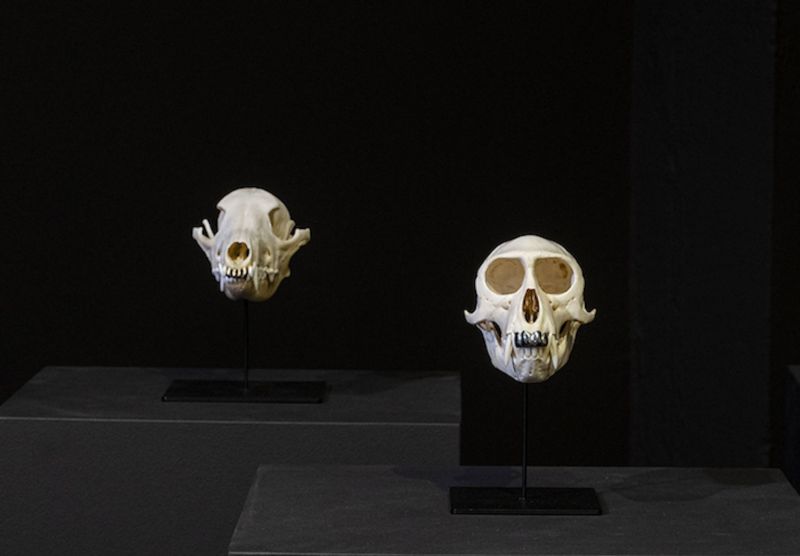
A detail from Yassin’s “Death Investment,” 2014-2023, on show at BAC through Sept. 7, 2024. (Courtesy of BAC)
BEIRUT — A dozen skulls are arrayed in a row, like an exhibit in a natural history museum or evidence in a forensics lab. Mounted on its own black plinth and set against a pitch-dark background, each skeletal head seems to glow — from both its bone whiteness and the gold, silver or copper teeth adorning its fixed grin.
“Death Investment,” 2014-2023, as this installation is titled, is a collaborative project Raed Yassin worked on with his childhood dentist. The piece’s exhibition tag places it in the art historical context of the memento mori (the skull as reminder of human mortality) and of precious metal teeth which, for poor people, is an investment in their own bodies. For pop stars and methamphetamine users, it evinces different kinds of corporal gamble.
These skulls didn’t belong to humans, but monkeys, cats, foxes and beavers — even more precarious Earthlings.
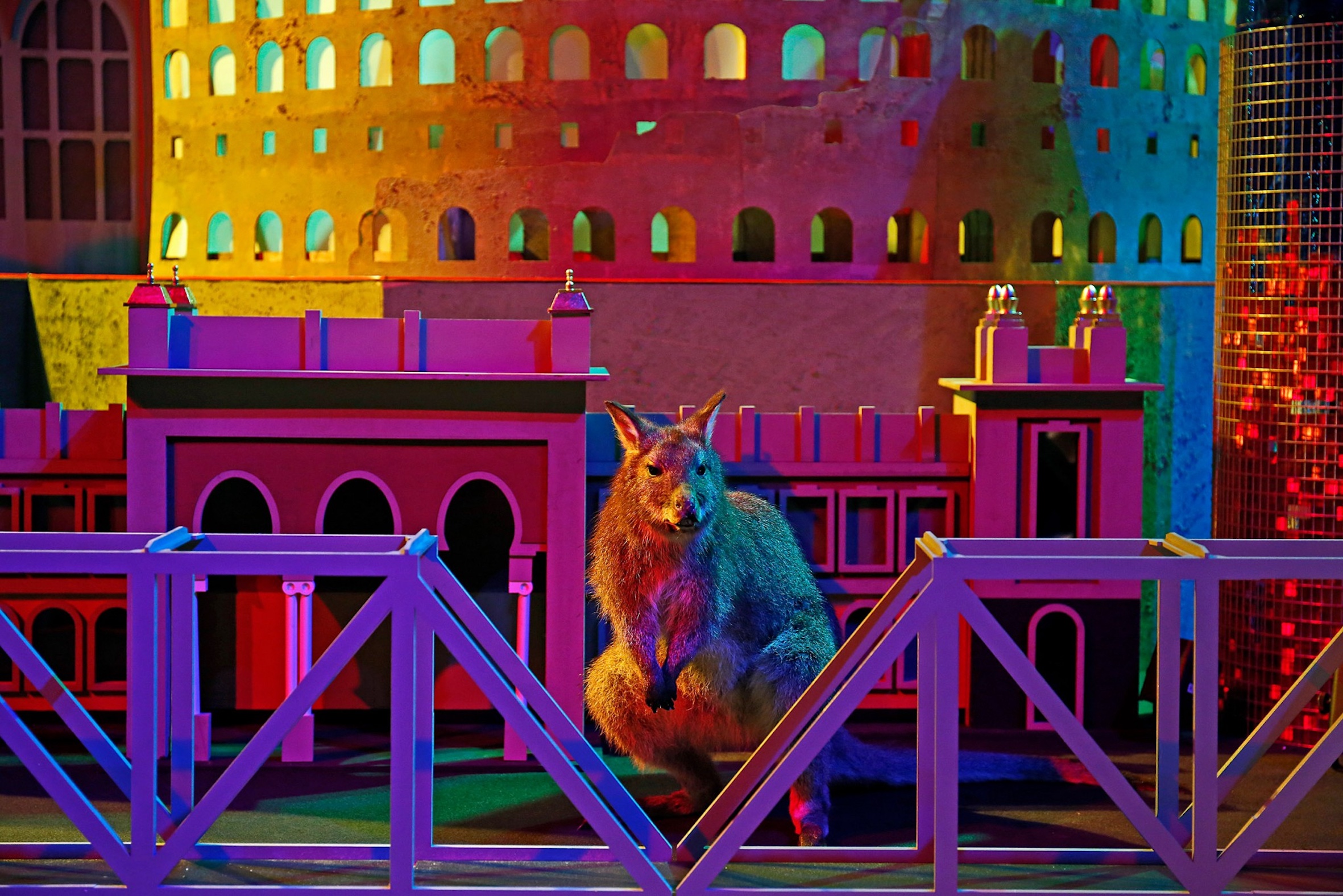 A detail from the installation at the center of the 58-minute musical video “The Sea Between My Soul,” 2020, on show at BAC through Sept. 7, 2024. (Courtesy of the artist)
A detail from the installation at the center of the 58-minute musical video “The Sea Between My Soul,” 2020, on show at BAC through Sept. 7, 2024. (Courtesy of the artist)
“Death Investment” is among the works on show in “Hell Between My Teeth, Phantom in My Heart, and Never-Ending Hum,” the artist’s first Beirut solo since relocating to Berlin in 2018. A multi-disciplinary artist, Yassin emerged as an improv musician — a stalwart of Irtijal, Beirut’s experimental music festival, and ensembles like A Trio and PRAED — before his visual art attracted the attention of curators and contemporary art biennials. “Hell Between My Teeth” opened April 18, a few days after Yassin performed a number of gigs at Irtijal 24.
“PRAED [his collaboration with Swiss instrumentalist Paed Conca] was playing Irtijal the Saturday that [Iranian] ballistic missiles were fired,” he chuckles. “It was a stressful moment. Like, what kind of karma is this?”
The road to Beirut
The 14 works on show at BAC run the formal gamut from neon light and commercial signage to video and sound installations, mural reproductions, photography, film, metallic floor tiles, balloon sculptures and pimped up mammal skulls. These pieces were devised or completed in the past four years, and are marked by the turmoil the world’s been undergoing since 2019 — pandemic, economic dysfunction, mounting climate disaster, war, famine, genocide.
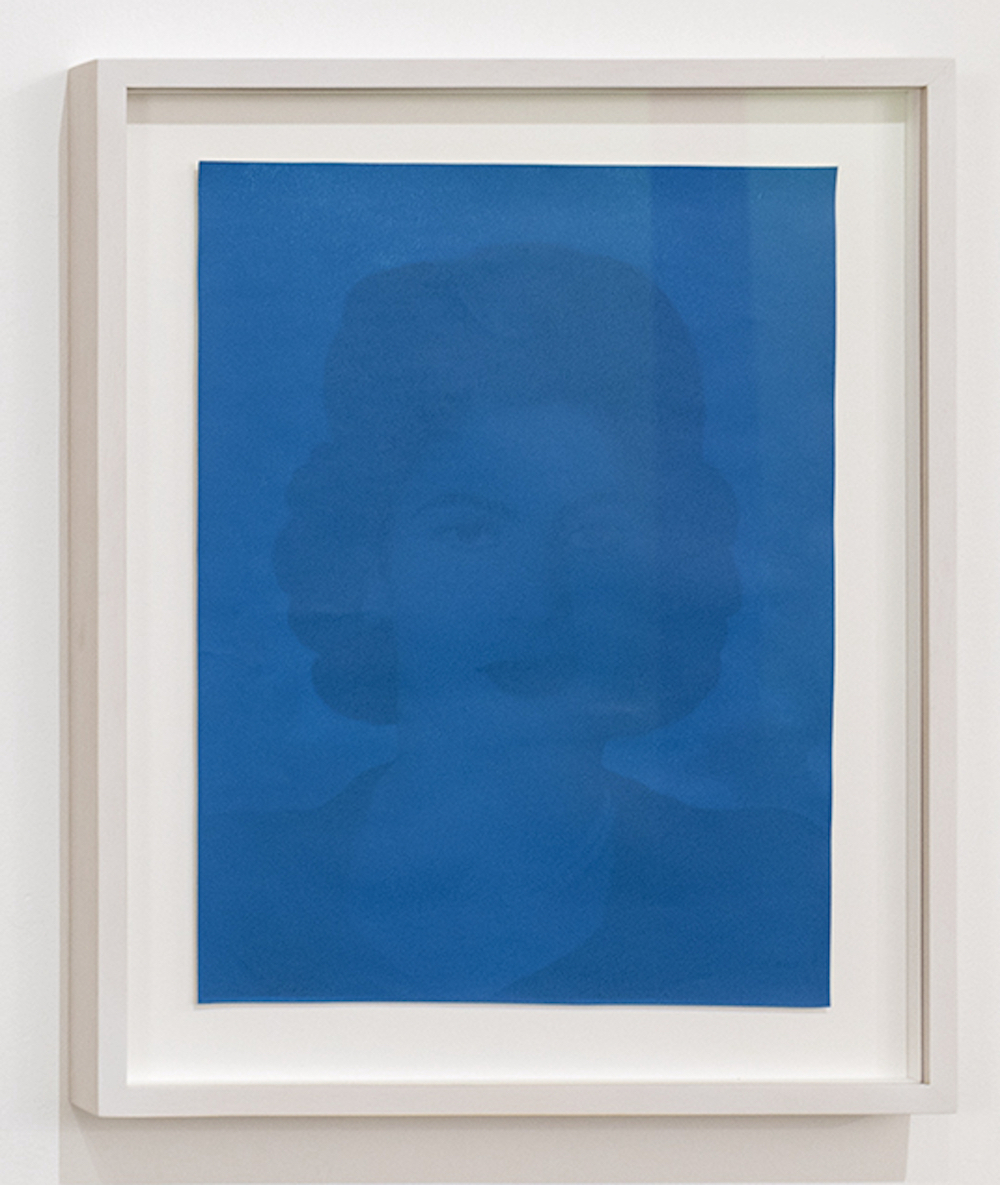 A photo from the series “The Company of Silver Spectres,” 2021-24, on show at BAC through Sept. 7, 2024. (Courtesy of BAC)
A photo from the series “The Company of Silver Spectres,” 2021-24, on show at BAC through Sept. 7, 2024. (Courtesy of BAC)
“After COVID, the way I experience life, the way I look at art and music changed a little bit,” Yassin says. “I was extremely busy before — with art, exhibiting, music, touring. You have to work to pay the bills. The first lockdown was really great because it gave me time to rethink the meaning of things …
“I’m becoming a very pessimistic person. I always see the end of the world coming,” he laughs. “So this is a show about the end of the world.”
“Yassin delves into themes of failure, death, loss, memory, and disappearance,” Reem Shadid writes in her curatorial statement. The works in this show interrogate “memory and the normalization of violence as fundamental elements in constructing narratives, [and] challenge notions of beginnings and endings.”
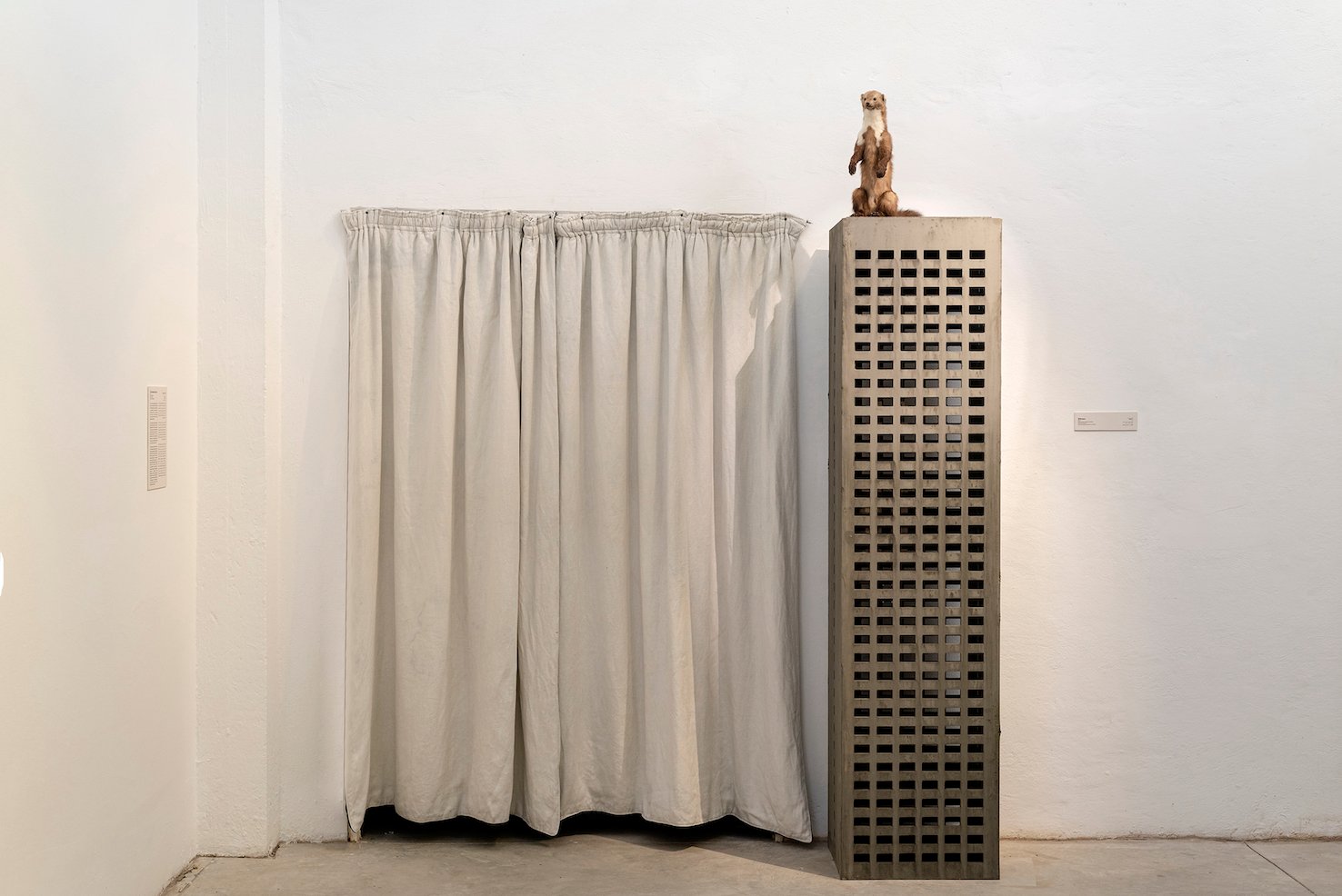 “Witness,” 2024, commissioned for “Hell Between My Teeth, Phantom In My Heart And Never-Ending Hum.” On show at BAC through Sept. 7, 2024. (Courtesy of BAC)
“Witness,” 2024, commissioned for “Hell Between My Teeth, Phantom In My Heart And Never-Ending Hum.” On show at BAC through Sept. 7, 2024. (Courtesy of BAC)
It’s not unusual for Yassin to work with images and media of the recent past. Versions of family members appear, and the ephemera of 1980s pop culture is endemic. Earlier pieces reference Beirut’s pigeon fanciers, Hippodrome horse race punters and Grendizer (the Japanese anime about an alien robot, dubbed into Arabic for local broadcast). Egyptian and Lebanese pop music (from Umm Kulthum to Sammy Clark), VHS tapes of Egypt’s commercial cinema, disco, karaoke, porn, fashion, celebrity, stuffed animals, neon lights, family photos, machine-worked embroidery and mass-produced china vases — all enter the warp and weft of Yassin’s oeuvre.
There are obvious departures in tone and location in “Hell Between My Teeth,” but echoes of past work can be heard too.
“I've been becoming obsessed about death,” he says. “You find it a little in earlier works — like the piece about my father [‘Yassin Haute Couture,’ 2018] — but in a different form,” Yassin says. “In a way I couldn't get more out of my earliest themes. I'm not done with them, but my thinking is going somewhere else.
 “You have won you Bastard!” 2024, a Japanese representation of Satan that greets BAC visitors, on show through Sept. 7, 2024. (Courtesy of BAC)
“You have won you Bastard!” 2024, a Japanese representation of Satan that greets BAC visitors, on show through Sept. 7, 2024. (Courtesy of BAC)
“Also, I moved to a new place. I have more time to myself in the studio. I have to deal with a new society, where people think differently than you. During COVID I had time to analyze why I'm there. What do I want to do? What is meaningful for me?”
Yassin also returned to Arabic poetry, specifically that published from the 1960s through the 90s. “Somehow, my works become more poetic too,” he reflects, “more minimal.”
His most-recent work on show at BAC is a 17-minute film titled “International Satan’s Day,” 2024, which first materialized in verse.
“I hadn't written a poem in 20 years,” he says. “All this death around us, that’s what pushed me to write it.”
The work was shot in Japan, largely in the southern resort town of Beppu, renowned for its spectacular hot springs, called Seven Hells — which lends its name to a photo series elsewhere in this show. Bookended by 8mm footage of a circling bird of prey, most of the film surveys Seven Hells’ landscape — spring water boils, mud pool bubbles rise and rupture, thick curtains of steam briefly part to reveal hints of buildings, walls and walkways. It might be an ad for climate change.
The work is looped in an exhibition room without score or soundtrack, with Yassin’s original poem accompanying the footage as subtitles.
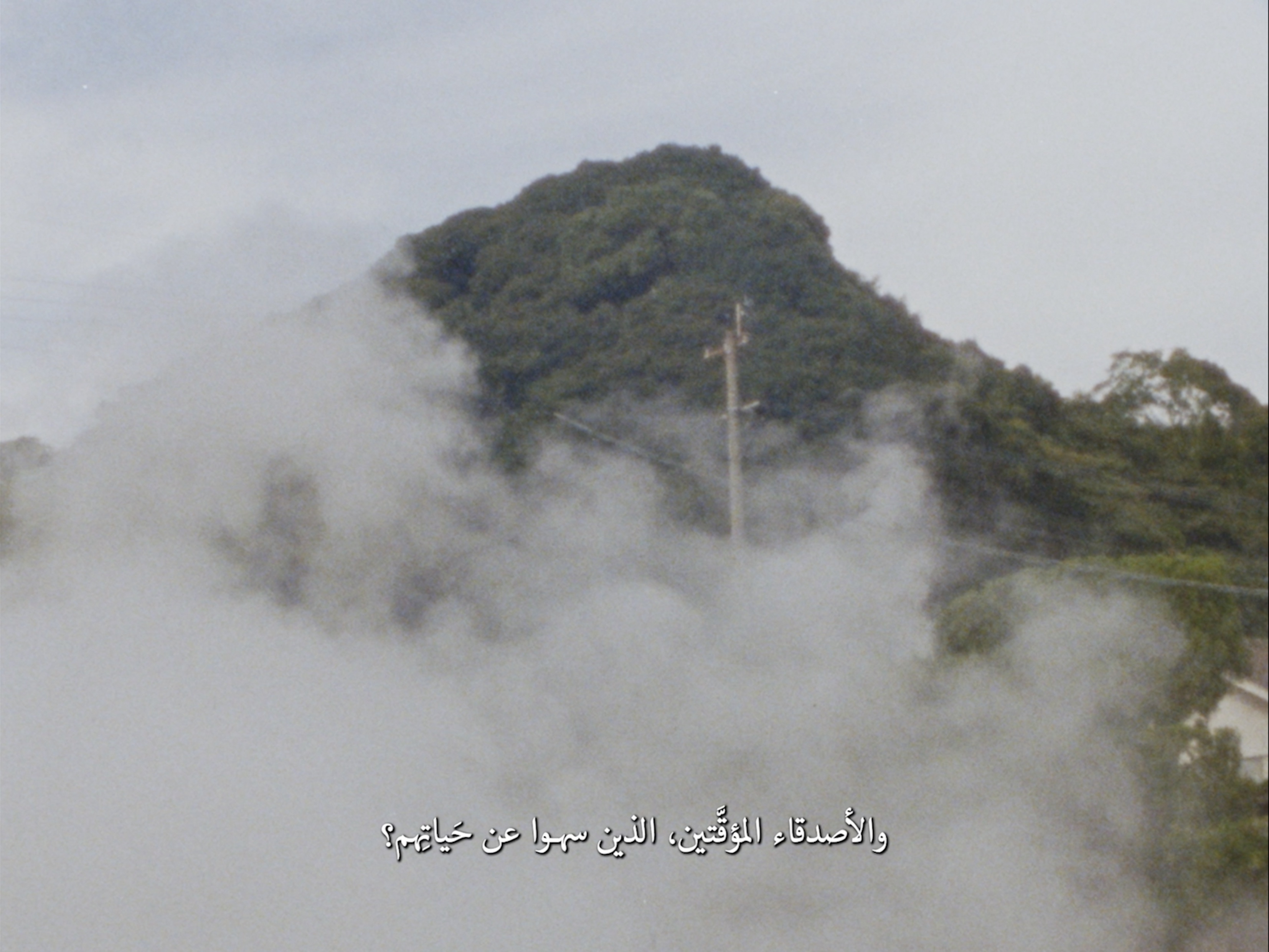 A still from the 17-minute 8mm film “International Satan’s Day,” 2024, on show through Sept. 7, 2024. (Courtesy of BAC)
A still from the 17-minute 8mm film “International Satan’s Day,” 2024, on show through Sept. 7, 2024. (Courtesy of BAC)
 A photo from the series, “Seven Hells,” 2024, on show at BAC through Sept. 7, 2024. (Courtesy of the artist)
A photo from the series, “Seven Hells,” 2024, on show at BAC through Sept. 7, 2024. (Courtesy of the artist)
“The whole city is steaming. The ground and the asphalt are very hot. The war on Gaza started when I was there.” He pauses. “Back in Germany the authorities’ oppression of anyone who says anything pro-Palestine was really hardcore. Now it’s better. Also a very dear friend [Reuters videographer] Issam Abdullah was killed a few days into the war and my head couldn't handle it. So this piece came to be about that — that what we lived and what we are living today and what we’re going to live in the future, is never-ending hell.”
Many of the show’s 2024 pieces have a Japanese accent. The front and rear ends of BAC’s central hall are guarded by a pair of cartoon-on-particleboard depictions of Satan in a loincloth (apparently holding a battered cricket bat), titled “You have won, you bastard!” A similarly attired Satan resides in the mural “The Devil, Crocs and the Monkey” (rendered by Ali Merhi), a selective reproduction of a wall mural found near Seven Hells. The photo series “Seven Hells” echoes the imagery of “Satan’s Day,” while “The Sunset of Stardom,” revisits Yassin’s interest in celebrity, through the lens of Japanese pop music and its young enthusiasts.
A number of sound-based works from 2020 were developed during the COVID crisis and its attendant social isolation. The 23-minute performance video “Humming in Abandoned Places” finds seven vocalists in derelict interior locations. As the performers hum in unison, their ensemble vocalizing slips from dissonance to harmony.
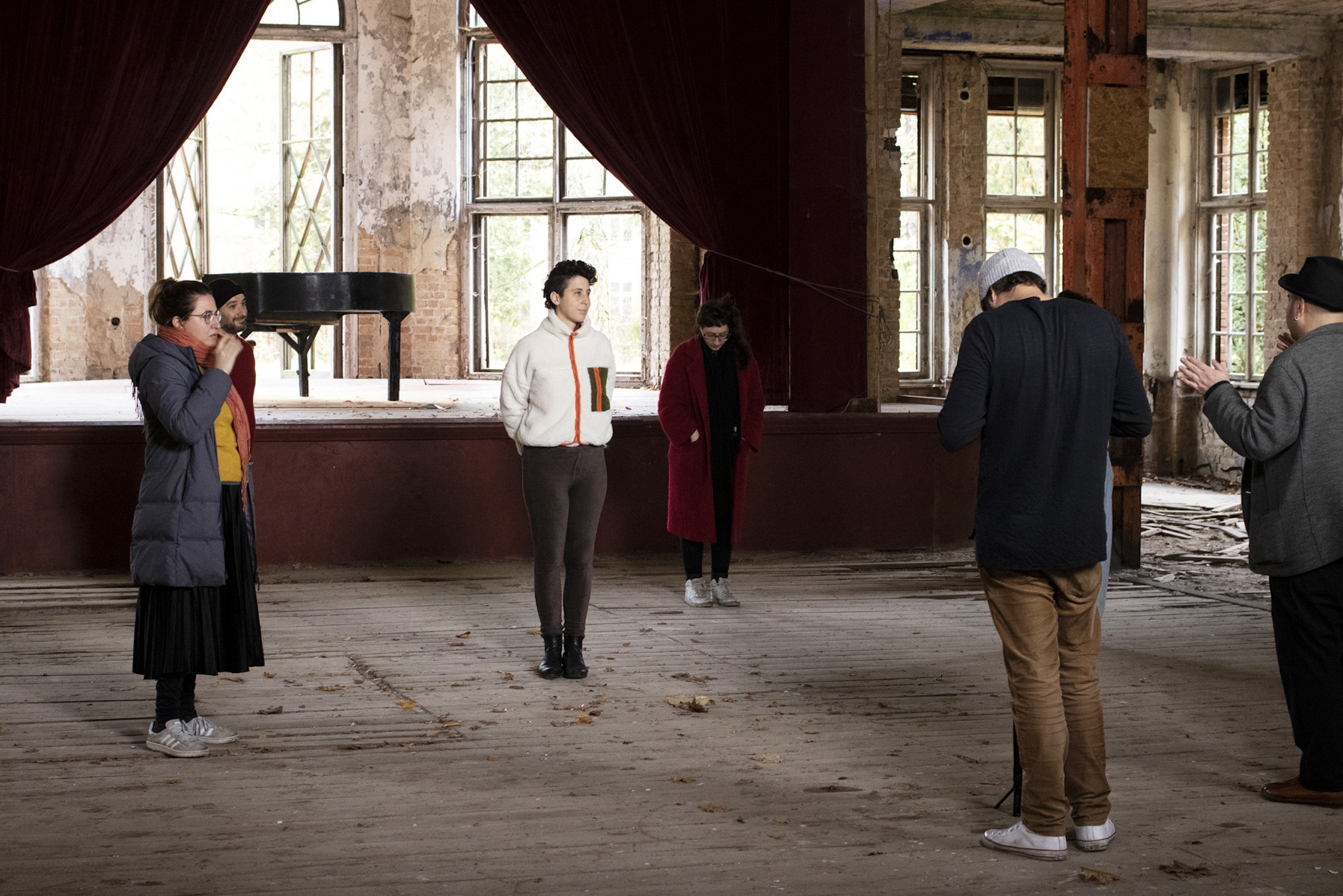 A photo from the production of “Humming in Abandoned Places,” 2020, on show at BAC through Sept. 7, 2024. (Courtesy of the artist)
A photo from the production of “Humming in Abandoned Places,” 2020, on show at BAC through Sept. 7, 2024. (Courtesy of the artist)
Europe’s strictly enforced mask regime inspired the composer to think about ensemble vocal performance without projected breath. The filming locations evoke abandoned public spaces, another feature of the pandemic, one of which formerly housed Germany’s first hospital for respiratory disease.
Humming also issues from the six-channel sound installation “A Small Leak of an Interior Monologue,” but it addresses the matter of human isolation very differently. In this case, visitors enter a hexagonal wooden booth where six voices emanate from six speakers, and the only visual stimulation are pairs of disembodied blown-glass eyeballs affixed to the walls. It is an entirely different experience from watching snippets of an ensemble performance.
“Making the performance video was a bit chaotic,” Yassin reflects, “working theatrically as a group, finding your voice in the community, starting very dissonant then coming together into one song. In the hexagon piece, the performers hummed the scales and I recorded each individual note, like on a piano. Then I wrote a composition for six voices. As for the eyeballs, there's just something eerie about seeing eyeballs in isolation, the violence it implies.”
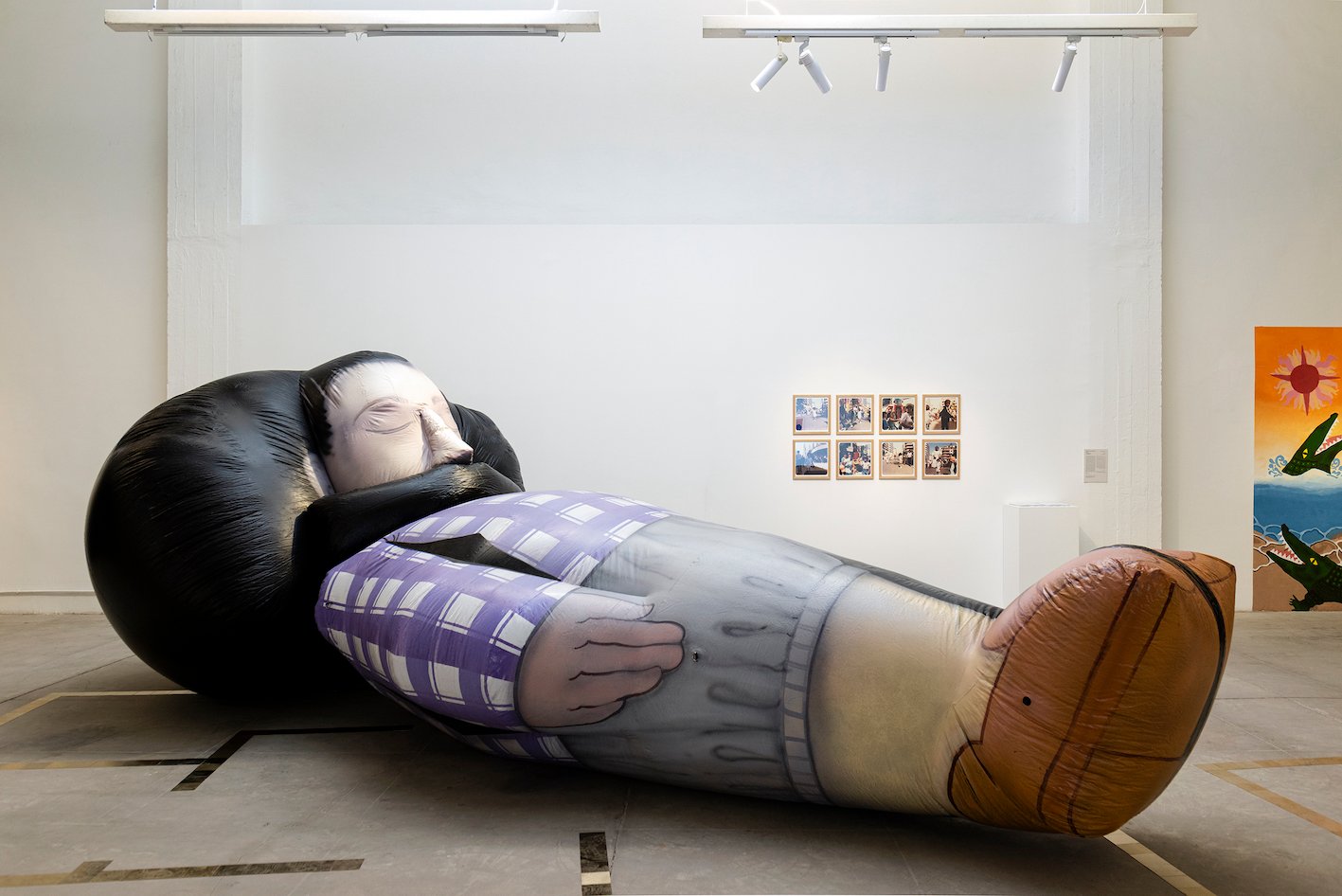 The multimedia work “The Theatricality of a Postponed Death,” 2022-23, on show through Sept. 7, 2024. (Courtesy of BAC)
The multimedia work “The Theatricality of a Postponed Death,” 2022-23, on show through Sept. 7, 2024. (Courtesy of BAC)
Next to the gallery entrance to BAC’s auditorium stands “Witness,” 2024, a maquette of Beirut’s derelict Murr Tower with a ferret-like taxidermy figure on the roof. The model could easily be part of “The Sea Between my Soul,” 2020, a rock opera on video running in hour-long loops in the auditorium.
The piece features an elaborate set design of models of architecture recognizable from various Mediterranean cities. Its characters are an assortment of stuffed animals. Most of the installation is in shadow at any given time, with stage lighting and neon signage illuminating individual animals as they relate their untimely demise in song. Who better to pen these lyrics and voice these characters than indie music legend Alan Bishop (Sun City Girls, Sublime Frequencies, Invisible Hands).
“The Sea Between My Soul,” Yassin explains, was an installation “meant to premiere on 13 March 2020, the day they declared the lockdown [in Germany]. The show was ready but we couldn't open. The scenography, the animals and buildings alone, stayed on stage for three months. So we made the film based on that, because we needed to premiere the fucking thing.
“It was one of my first major commissions,” he recalls. “Then, you know, I see all these daggers coming at my heart. I'm happy I made this film. Now I can show the work more easily, because shipping prices have gone crazy lately and no one has the budget to ship this container.”
 An interior view of the six-channel sound installation “A Small Leak of an Interior Monologue,” 2021, on show through Sept. 7, 2024. (Courtesy of BAC)
An interior view of the six-channel sound installation “A Small Leak of an Interior Monologue,” 2021, on show through Sept. 7, 2024. (Courtesy of BAC)
Enduring Lebanon
The centerpiece of “Hell Between My Teeth” is the multimedia installation “The Theatricality of a Postponed Death,” 2022-3, which evokes two figures from Lebanon’s 20th-century cultural history.
“During COVID I became more nostalgic about my teenage years in Beirut,” Yassin says. “I didn't know if that time was interesting or if my nostalgia is just making me think it was, but I became obsessed with collecting things that are disappearing from my Beirut.”
The most prominent component of the piece is the meters-long inflatable sculpture of a comatose man wearing short trousers, a prominent mustache and an immense mullet, which provides a pillow for his head. Many Lebanese would recognize the figure as the much-loved performer Hassan Aladdin, aka Shushu (1939-75), a stage and screen star who worked energetically to found a national theater. He abruptly died in 1975, after the civil war broke out.
The other figure is Raif Karam, Yassin’s art school professor. In 1984, a particularly bleak period in Beirut, he staged the Festival of Happiness, a surreal carnival-style musical march from the city to the sea that drew in performers and bystanders alike. A text depicting this anti-war intervention, written by cultural activist Rana Issa, accompanies photos documenting it, taken by Abed al Hakim Issa.
 “Humming in Abandoned Places,” 2020, a 23-minute video performance, on show at BAC through Sept. 7, 2024. (Courtesy of BAC)
“Humming in Abandoned Places,” 2020, a 23-minute video performance, on show at BAC through Sept. 7, 2024. (Courtesy of BAC)
“This is part of a bigger work,” Yassin says, nodding to the Shushu piece. “I couldn't ship everything because of financial issues. Originally, this project was commissioned by the Steirischer Herbst [Styrian autumn] festival in Austria and staged as a street performance. Shushu was filled with helium, so it was flying. Local actors wore papier maché masks of performers who worked with Shushu. A marching band played Shushu’s music, [which Lebanese jazz pianist Tarek Yamani] rearranged for a New Orleans-style funeral cortege. It was a funeral for Shushu, which kind of embodies Lebanon for me. At the same time, it was an homage to Raif Karam.”
Like Karam’s Festival of Happiness, Yassin staged his intervention only once. “I want an exhibition that makes the parade’s objects into something like museum objects.”
He pauses. “In Austria it had a completely different meaning. The curator wanted to embed it in her own view of the war happening in Europe.” He chuckles. “She’s Russian, and to be Russian in Europe right now is to be evil, so she needed to do an exhibition against the [Ukraine] war to prove otherwise.”
The credits of “Satan’s Day” inform viewers that Yassin’s poem was inspired by the work of Syrian poet Muhammad al-Maghout (1934-2006), who published in Shi3r, the Lebanese poetry magazine founded by Yousef al-Khal, Onsi al-Hajj and Adonis.
“Maghout was very special,” Yassin says, “somebody who was coming from the village in Syria, so for him Beirut was like a real city. He has a very different language from those who were writing here, direct but strongly allegorical. He also wrote theater pieces. There is nobody like him in the Arab world.
“But there's a lot of Arabic poetry that speaks to what’s going on today,” he adds. “We live in a region that really has a lot of poets. History just put them in a position where they had to write about what's going on around them. This has not stopped.”
“Hell Between My Teeth, Phantom in My Heart, and Never-Ending Hum,” is up at BAC through September 7, 2024.
